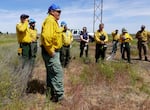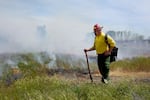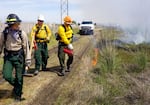
Raymond Huesties, board member and firefighter with the Confederated Tribes of the Umatilla Reservation, speaks to students and instructors at a prescribed fire training outside Hermiston, Ore., on May 15, 2024.
April Ehrlich / OPB
When Raymond Huesties first became a firefighter for the Confederated Tribes of the Umatilla Indian Reservation in Eastern Oregon, he didn’t really have much of a choice.
“My boss gave me a hard hat and a fire shirt and said, ‘You’re a firefighter now,’” Huesties recalled in mid May, as he stared out into the grassy wetland of the Wanaket Wildlife Area outside Hermiston. That’s where he had joined about two dozen other people on a prescribed burn.
When it comes to fire, Huesties plays two roles: firefighter and fire starter. He fights fires that overtake buildings in town, then he sets fires to wild areas as a way to tamp down overgrowth.
He had joined the Nature Conservancy and several fire agencies on this three-day training to teach people how to safely use fire as a tool. Many of the students were from the reservation.
He said the tribe continues to struggle to recruit young tribal members into firefighting, but maybe they would be interested if they got a taste of the excitement. He himself learned to love the adrenaline from the job.
“I always tell them that we’re all different,” Huesties said. “We’re not the same as the general public. We’re not the same as anything on this planet because everything on this planet — even the bear, the biggest boss of the woods — runs from what we run to.”

John Boyd, a staffer with the Bureau of Indian Affairs and resident of the Confederated Tribes of the Umatilla Indian Reservation, watches a prescribed fire burn outside Hermiston, Ore., on May 15, 2024.
April Ehrlich / OPB
Fire is also important to the tribe’s culture. Before colonization, the Umatilla tribe and many other Northwestern tribes used fire to replenish lands. Those fires burned grasses and underbrush, adding nutrients to the soil and helping plants germinate.
“The fire part is very sacred because it consumes everything, and it also rejuvenates everything,” Huesties said. “After you get a burn, that’s where you go to the next year, because your mushrooms are going to be there.”
For decades, federal agencies aggressively suppressed fire and forced tribes to stop burning the land. Several studies in recent years have shown that fire helps keep forests healthy by making them more resilient to catastrophic wildfires, pests and diseases.
“There’s awareness of the inherent value of relating with fire on the landscape,” Day MacKendrick, fire specialist with the Nature Conservancy, said at the burn. “Prescribed fire offers one pathway for people to be able to work in relationship with each other and fire.”
Now government agencies in the U.S. are increasingly embracing prescribed burning as a way to mitigate catastrophic wildfires. But for Huesties, that knowledge has been here all along.
“We just haven’t utilized it because no ‘ologist’ has discovered it,” Huesties said. “I don’t claim to be an ‘ologist.’ I don’t claim to be a scientist. I’m just a firefighter and I listen to my elders.”
That’s also what brought Huesties to the prescribed burn training: to pass on lessons of his elders to a new generation of young people.
“I’m trying to build them up and make them want it more, because I don’t want to do it anymore,” Huesties said. “I’m getting old.”

Jeremy Wolf, right, a citizen of the Confederated Tribes of Umatilla Indian Reservation, uses a drip torch as part of a prescribed burn outside Hermiston, Ore., on May 15, 2024.
April Ehrlich / OPB
The tribe often sets a goal of burning a certain number of acres within a year, but modern rules and laws also present their own challenges. Tribes and other fire agencies need to follow certain parameters to ensure prescribed burns don’t get out of control or send smoke into nearby communities. This “prescription” usually calls for specific weather conditions. The humidity, wind direction and wind strength all have to be just right.
“A lot of times it’s gambling with the weather and air quality,” Huesties said. “That’s the difficult part.”
The prescribed burn was supposed to start that morning, but the winds kept blowing west, when the prescription called for an “easterly wind.” Students were kept busy by digging lines around sagebrush and other plants they wanted to protect.
It wasn’t until late afternoon that the winds shifted, but by then, Huesties had to take off. In addition to fighting fires for the tribe, Huesties is on its board of trustees, so he had to run to a meeting. After singing a blessing with another tribal leader, Huesties left the students with a speech.
“Thank you for all your hard work,” he told them. “I hope you guys succeed and learn and actually witness what this fire can do, the benefit of putting fire on the ground.”
With that, instructors guided the students through gearing up with drip torches and setting the field ablaze.

From left, prescribed fire instructors Joe Winckler and Kylie England create a fire column among tall grasses. The column will send embers high enough into the sky that they will cool before they hit the ground.
April Ehrlich / OPB
